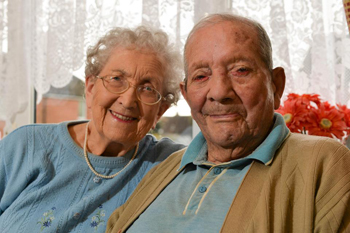London, Mar 28: The key to a lasting marriage is a hot meal every night and 'looking in your purse' while shopping, say couple, believed to be Britain's longest-wed, ahead of their 77th anniversary.
 George Loftus, 100, and wife Phyllis, 94, have seen 16 prime ministers take office since they married.
George Loftus, 100, and wife Phyllis, 94, have seen 16 prime ministers take office since they married.
They met in the 1930s and married at a register office on August 10, 1940, when she was just 17.
Phyllis revealed the secret of her long marriage to George was a "good meal and a chat".
"Couples are not the same these days. If people loved each other like we do, it would be a better world. My mother gave me these guidelines 75 years ago and we have kept to them," Phyllis was quoted as saying by the Walsall Advertiser.
"When shopping and you see something, look in your purse and if you can afford it and need it, ok. If not then shut your purse," she said.
"Always keep your husband well fed. We always have a good hot meal every night and a chat...We've done that every night of our marriage and it's kept us strong," Phyllis said.
They first started dating before World War-II, when Phyllis was a trainee nurse at Birmingham Children's Hospital.
In the 76 years since, George has worked as a fireman, a pit worker and a metal labourer until he retired in 1981 at the age of 64.
Meanwhile, Phyllis became a bus conductor, before working as a councillor for Chadsmoor on Cannock Urban District Council in the 1950s.
She then moved on to become a judicial official in 1963 and was a magistrate for 30 years before retiring at the age of 70.
Despite reaching such high office, Phyllis has always seen feeding her loving husband as her main priority.
"I was a housewife. I have always cooked. We don't have any convenience food in this house. It's all done by me," Phyllis said.
"When the pension comes in we have always sat either side of the table and worked out what we can spend. We have never owned a house, owned a car, never drank of smoked, because we have always had what we can afford. But we have never owned a penny," she said.
"I have always said as long as there is good food on the table that's all that matters. The way to a man's heart is through the stomach," she added.





Comments
Add new comment